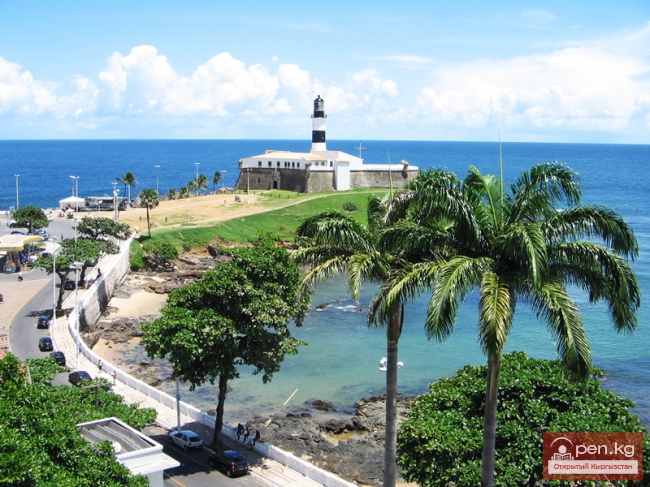CAPE VERDE. Republic of Cape Verde
An island nation located in the Atlantic Ocean off the coast of West Africa. The archipelago consists of 18 islands, of which 10 are large, including 9 inhabited ones. The area is 4,033 km². The capital is Praia (on Santiago Island) with approximately 113,000 residents.
Administrative division - 14 districts. Population - 463,000 (2005); consists of mulattos of Portuguese-African descent (about 71%), Bantu (28%), and Europeans (mostly Portuguese) - 1%. The official language is Portuguese (Creole is also widely spoken). Religion: about 90% of the population are Catholics. The currency is escudo = 100 centavos.
It has diplomatic relations with the Russian Federation (established with the USSR on July 14, 1975).
National holiday - July 5 - Independence Day.
Cape Verde is a presidential republic. The head of state is the president, elected for a term of 5 years. The last elections were held in two rounds in February - March 2001, resulting in victory for Pedro Verona Rodrigues Pires. The highest legislative body is the National Assembly (unicameral parliament), consisting of 72 deputies elected by universal suffrage for 5 years. In the last elections, the African Party for the Independence of Cape Verde (PAICV) won the majority with 40 seats. The Chairman of the National Assembly (since January 13, 2001) is Aristides Raimundo Lima. The executive power belongs to the government (formed in May 2004), which has broad powers and consists of 12 ministers and 4 secretaries of state. The Prime Minister (since January 25, 2001) is José Maria Pereira Neves (chairman of PAICV).
Political parties: African Party for the Independence of Cape Verde (PAICV), Movement for Democracy (MPD), Democratic Party (PDC), Labor and Solidarity Party (PTS), Social Democratic Party (PSD), and Christian Democratic Party (UDC - PDC). In 2000, the Democratic Renewal Party (PRD) was established.
The islands of Cape Verde were discovered by the Portuguese in the mid-15th century (until 1986, the Soviet literature referred to the islands and the official name of the country in translation from Portuguese as the Islands of the Green Cape and the Republic of the Islands of the Green Cape). From 1581, the islands came under Spanish control. From 1640, they became a colony again, and later an overseas province of Portugal.
On July 5, 1975, as a result of the struggle of Cape Verdeans that began in 1963 led by the African Party for the Independence of Guinea-Bissau and the Islands of Cape Verde (PAIGC), independence was proclaimed. After a coup in Guinea-Bissau in November 1980, which transferred all power in that country to the Revolutionary Council of PAIGC, the Cape Verdean wing of PAIGC constituted itself as an independent party - PAICV. In January 1991, multi-party democratic elections were held in Cape Verde, in which the MPD party won. In August 1992, a new constitution was adopted. The most recent parliamentary elections were held on January 14, 2001. PAICV won, receiving about 48% of the votes.
Cape Verde is a member of the UN (since 1975), the African Union, the Non-Aligned Movement, and the Community of Portuguese Language Countries (CPLP).
The country's economy is underdeveloped, primarily due to a lack of natural resources and an unfavorable climate (drought and lack of fresh water sources). According to the UNDP classification (2004), Cape Verde ranks 105th in terms of human development. The total GDP in 2004 was $610 million. The share of agriculture in GDP is about 10%, industry is around 16%, and the service sector, including trade and tourism, accounts for up to 74%. The per capita income is $1,380 per year.
The inflation rate in 2004 decreased (-1.6%). Economic growth in 2004 was 4.5%. The main factor determining the viability of the economy remains significant foreign aid, as well as concessional loans (in 2004 - $112.9 million) and remittances from the Cape Verdean diaspora ($95.3 million in the same year). At the same time, the volume of foreign investments in the country's economy for 2004 amounted to $41.5 million, directed towards infrastructure construction (roads, electricity and water supply networks, reservoirs). Agriculture is low-yielding (the country produces up to 30% of the necessary agricultural products). Sugar cane, bananas, coffee, castor beans, corn, potatoes, beans, cassava, tomatoes, and fruits are grown mainly on irrigated lands. The sector employs 47% of the working-age population. The area of cultivated land is 42,000 hectares (10% of the total area of the archipelago). Fishing employs 2.5% of the active population of the country. The main part of seafood is exported to European countries. Industry is weakly developed (16% of the country's GDP). It is mainly concentrated on 3 islands: Santiago, São Vicente, and Sal (about 80%), where food, textile, and footwear industries, as well as construction material enterprises operate. There are also a national airline, construction, automotive, and ship repair enterprises. Salt is extracted (on Sal Island, Maio Island), pozzolana (on Maio Island), clay, and basalt.
The foreign trade turnover in 2004 amounted to $387.5 million compared to $375.68 million in 2003. The main export items are leather products (footwear - over 50%), seafood, and textile products. About 26% of imports are food. Electrical equipment (17.35%) and energy resources (9.9%) are also imported. The most active trade and economic relations are maintained with Portugal (which accounts for 81.4% of exports and 48.8% of imports of Cape Verde), the Netherlands, the USA, Germany, Spain, and France.
There are 5,600 km of roads, including 800 km of asphalted roads. The main port is Mindelo. An international airport operates on Sal Island.
The country publishes newspapers "Tribuna" and "Voz di Povo." There is a government information agency "CaboPress" and 2 government radio stations. Since 1984, national television has been operating.












































